
When someone mentions reptile, the first thing that comes to our minds are the creepy crawlies – crocs, snakes, lizards and turtles. They share characteristics of both amphibians and mammals but are different in that they lack feathers as in birds, hair as in mammals and moist skin as in amphibians. Let’s take a closer look at these diverse species and list their unique characteristics.
Reptiles are commonly classified into four major orders:
Testudines include species like the tortoises and turtles.
Crocodilia is comprised of around 23 species which includes alligators, crocodiles, caimans and gharials.
Squamata covers around 7,900 species including snakes, lizards and amphisbaenids (commonly known as worm lizards)
Sphenodontia consist of just 2 species of Tuatara (nocturnal burrowing lizard-like reptile with a crest of soft spines along its back.)
When faced with danger, reptiles would rather retreat than fight. Only when pushed too far, will it attack. We recommend you don’t take that chance. Just to remind you, reptiles include poisonous snakes, ferocious crocodiles and many species of creepy lizards. At the first hint of trouble, snakes and lizards will crawl into their borrowed homes. A crocodile or a turtle will just submerge itself underwater and sink out of sight. Camouflage is used when reptiles want to avoid a confrontation. They blend in remarkably well with their surroundings. When escape is not possible different species of reptiles adopt different defence strategies. A crocodile will open its mouth to expose its teeth, and if this fails in getting the enemy to back down, it makes agitated hissing sounds. This is followed by a dramatic change in posture; the body is inflated to appear more intimidating.
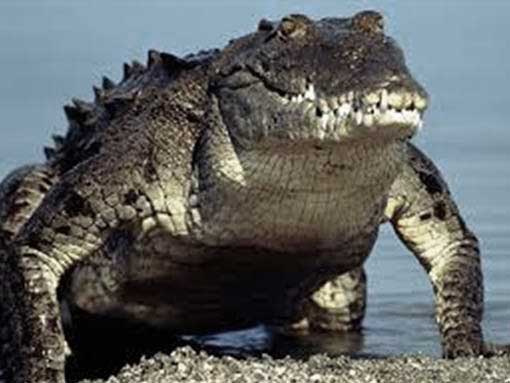
Snakes on the other hand have a different approach to danger; some will raise their heads, and spread out the skin of their necks to appear more of a threat. If this doesn’t work they take position and get ready to strike. Poisonous snakes like the viper and cobras deliver venom through their fangs from venom glands. While the non-poisonous ones just play dead.
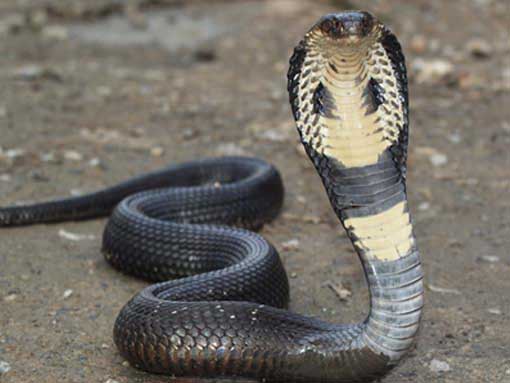
Some species will try to bite first; others will run out of their humble abodes to chase a threat standing at a distance and even chase after them onto land.
Lizards shed their tail, which wriggles even after it’s detached from the body and distracts the pursuer, who perceives it as a continued new threat. The free lizard can grow back a tail over a period of weeks. The tail is often of a more vivid colour as compared to the rest of the body, prompting the potential predator to strike first for the tail area.
Scaly skin
Reptiles have scaly dry skin very different from their bird, mammal and amphibian contemporaries. Their skin has cutaneous glands with high levels of keratin, which unlike amphibians, prevents water loss through the skin. The scales and scutes are developed as surface cells fill with keratin.
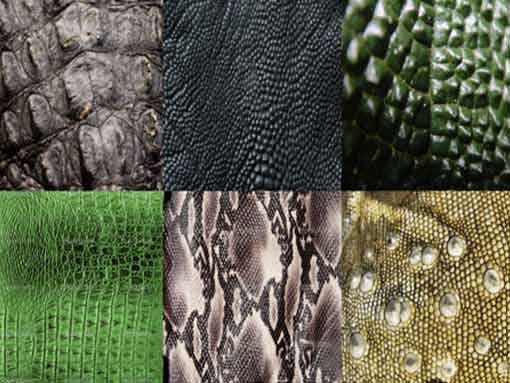
And a tiny pimple can get girls frenzied
Four legs or No legs
Reptiles are tetrapods or in more simple terms they have four limbs or four-limbed ancestors. In the snake and worm-lizard, legs are absent but it is believed that they have evolved from tetrapod ancestors. The ones that do have legs sport five clawed toes on each and they are angled downwards to facilitate faster locomotion.
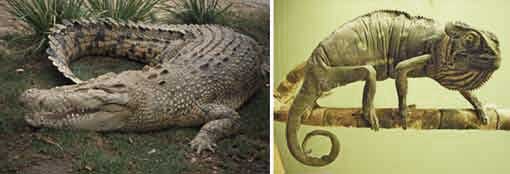
Lungs in a pair for breathing fresh air
Unlike fish, reptiles use well-developed lungs for respiration and don’t pass through an embryonic stage with gills as in amphibians. Our poetic heading however doesn’t apply entirely to some snakes that own a single lung and make do with it.

Cold-blooded crawlies
Reptiles are ectothermic or cold-blooded creatures. This means they depend entirely on the ambient atmosphere, for maintaining body temperature, unlike mammals that are warm-blooded (endothermic) and are capable of generating heat internally. This is the reason why reptiles are absent in the Antarctic region. Reptiles move from hot to cold environments to warm up or cool off and if the temperatures are not to their liking they go into hibernation. As a reptile’s temperature rises it becomes more active and energetic and if it drops you’ll have a lazy lizard for company. Being cold-blooded they have lower metabolism as compared to the warm-blooded mammals and hence need to feed every so often.

All reptiles have a three-chambered heart, except crocodiles, which have four-chambered hearts that consist of two atria and two ventricles like that of mammals and birds. The three-chambered heart consists of two atria and a partially divided ventricle. The job of the atria is to receive blood and that of the ventricle is to pump it.

Reptiles lay eggs in much the same way that birds and amphibians do, however these eggs differ from amphibian eggs in that they are amniotic that can be laid on land and not in water. These eggs can survive without water. Most reptiles lay eggs but some give birth to young ones by hatching the eggs inside the body of the mother. When the eggs hatch, the reptiles look like miniature versions of their adult counterparts with no metamorphosis as in the case of amphibians.
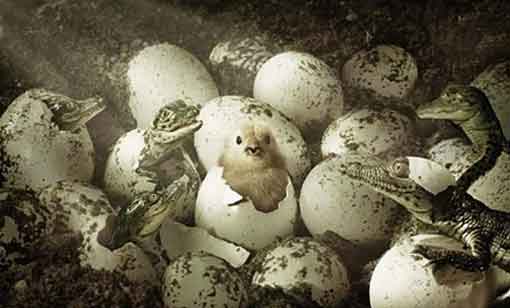
Uh Oh...
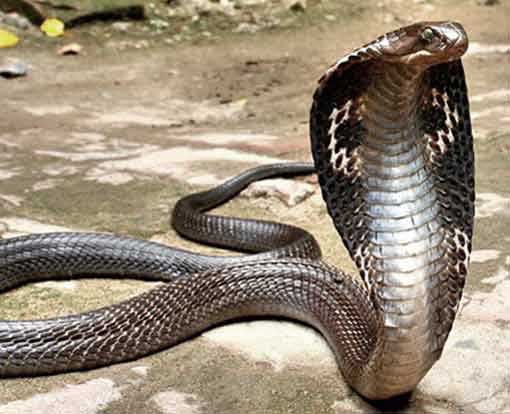
Ssssssssstay away!
The King Cobra is the longest venomous snake in the world! And one bite contains enough venom to bring down an elephant. King cobras can reach 18 feet in length and when confronted, they can literally stand up raising one third of their bodies straight off the ground whilst moving forward to attack. The hiss of the king cobra can be bloodcurdling and though the venom may not be as strong as other poisonous snakes the neurotoxin they deliver in a single bite is enough to take the life of 20 people. Cobras are generally shy creatures and choose to keep away from humans most of the time, but if cornered, this poisonous reptile will get fiercely aggressive. They rest in trees, on land, and in water and are mostly found in the rainforests of Southeast Asia, southern China and the plains of India. They prey on lizards, eggs, small mammals as well as other snakes. Cobras can hear but are deaf to ambient noises and sense ground vibrations instead. So the effort that you see a snake charmer put into playing his flute is actually falling on deaf “ears”. The snake is enticed by the shape and movement of the flute rather than the melody. They are the only snakes in the world that build a nest for their eggs and guard them viciously until they hatch.
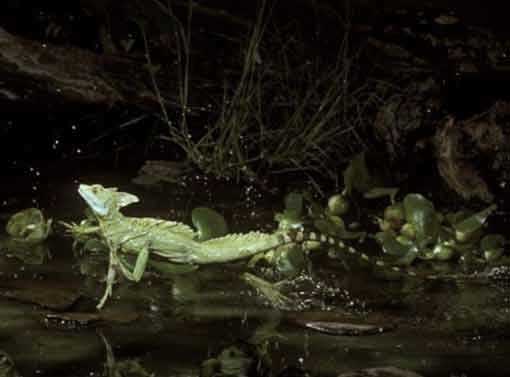
Jesus walked on water, Peter followed.... and this little guy tagged along
The Green basilisk lizard aka the Jesus Christ lizard gets its famed nickname from its miraculous ability to walk (more like run) on water. They are able to do this owing to the long toes on their rear feet with fringes of skin that open up in the water increasing surface area. They slap their splayed feet hard against the water while rapidly churning their legs. This process creates a tiny air pocket that keeps them from sinking provided they maintain speed. They can keep this up for 15 feet or more when ultimately gravity takes over and the basilisk returns to its exceptional swimming skills to continue its voyage. It can even stay under for about 30 minutes. These little marvels are found in abundance, sprinting upright about 5 feet per second across the surface of the water in the tropical rain forests of Central America, from southern Mexico to Panama and always pick quarters in trees close to water bodies. Their predators include snakes and birds. The males have a distinct high crest on their heads and backs and use this to woo the ladies. These omnivores grow to about 2 feet in length, inclusive of the tail and their diet includes insects, plant material and even small vertebrates. Pregnant females can lay up to 20 eggs in a self made shallow trench which they leave to hatch on their own. The new-borns are equipped with the ability to run on land and water, swim and even climb.
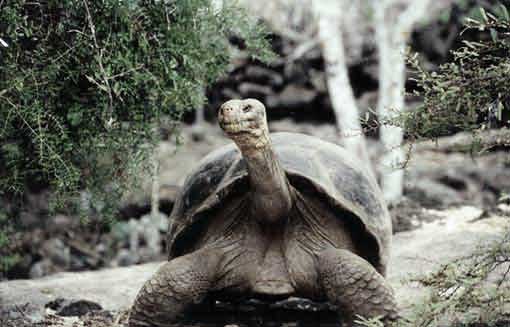
History is seen by these victors
But in the case of the Galápagos Tortoise it was probably written by the survivors. The Galápagos surviving to this day was probably one of the first to read Mark Twain’s The Adventures of Tom Sawyer and then came up with his own version of The Tortoise and The Hare. I mean for Pete’s sake, how could the hare possibly loose a race to a tortoise? The tortoise can barely cover about 15 feet in 43 seconds while the hare can run at a speed of about 40 mph (that’s 3300 feet in a minute).
This giant tortoise is the longest living of all vertebrates, with the oldest living up to 152 years. They are also the world’s largest tortoises and can exceed 5 feet in length. Their menu includes grass, leaves and cacti and they can survive up to a year without food and water owing to their slow metabolism and large internal stores of water. They nap for 16 hours a day. Galápagos is the Spanish word for tortoise and this name was given to them by Spanish sailors who discovered them in 1535.


